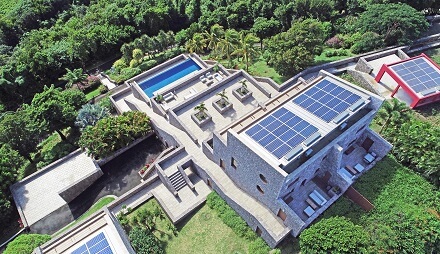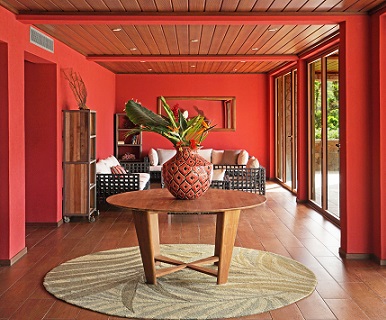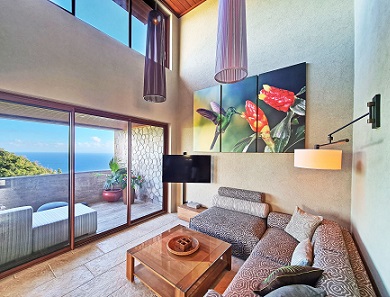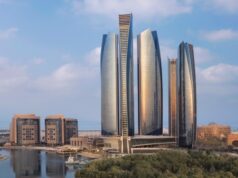 DOMINICA—One of the planet’s most outstanding examples of a modern, off-the-grid eco-luxury resort is Coulibri Ridge. It is in Dominica amid 285 acres. The 14-suite property is powered by sun and wind and is the result of more than 20 years of research, environmental testing, infrastructure building, and community engagement to ensure the highest degree of sustainability, respectful development, and community collaboration.
DOMINICA—One of the planet’s most outstanding examples of a modern, off-the-grid eco-luxury resort is Coulibri Ridge. It is in Dominica amid 285 acres. The 14-suite property is powered by sun and wind and is the result of more than 20 years of research, environmental testing, infrastructure building, and community engagement to ensure the highest degree of sustainability, respectful development, and community collaboration.
Coulibri Ridge is the brainchild of Quebec-born entrepreneur Daniel Langlois. Langlois traveled the globe throughout his career in software technology, and the contrast between wealthy and poor communities in many places left him pondering why sustainable practices like solar energy were not typically in place to help the world’s vulnerable citizens. As a result, he began researching sustainability and eco-friendly building practices before searching for a location to put his ideas into action. Langlois and his partner Dominique Marchand first visited Dominica, the “Nature Island,” in 1997, fell in love with the island’s natural beauty, and decided to build their dream.
Perched atop a mountain ridge in southern Dominica near the village of Soufrière, Coulibri Ridge is fully off-grid, using solar energy as its main power source, supplemented by wind turbines specially designed to have minimal impact on local flora and fauna. Rainwater, collected primarily through the resort’s unique roof design and purified by ultraviolet light and copper ionization, is funneled to guest suites and two shared, chlorine-free pools. Drains and gutters collect rainwater and grey water can be used to irrigate the resort’s gardens and a small farm.
Exterior Meticulously Designed
Inside the suites and all common areas, guests will find recycled teakwood, and ceilings are constructed from 100 percent recyclable, mold-resistant aluminum. The resort’s meticulously planned exterior, designed to stand up to hurricanes, earthquakes, and humid conditions, was built to be integrated into the natural landscape, allowing guests to truly feel connected with the land. The resort’s exterior was developed from hand-chiseled stone sourced from the property, constructed entirely by local community members who continue to service the resort in all capacities.
A strong focus on community is an integral part of Coulibri Ridge’s DNA. The resort was conceptualized and constructed to support the local community and offer opportunities for locals to become part of its success. This symbiotic relationship was particularly apparent in 2017 when Coulibri Ridge was nearly ready to welcome its first guests. Unfortunately, Category 5 Hurricane Maria had other plans. While the resort suffered minimal damage due to its deliberate design, the village of Soufrière was decimated. During this challenging time, Langlois and Marchand took the opportunity to temporarily step back from Coulibri Ridge and use what they learned in creating the resort to help the residents rebuild and become more resilient.
Green Lodging News recently interviewed Daniel Langlois about Coulibri Ridge. The questions and his answers are below:
Do you have a prior history working in the lodging industry?
My background is actually in design, technology and filmmaking. In 1986, I founded a company called SOFTIMAGE that developed advanced digital technology and 3D animation for the film industry that was used in movies Jurassic Park, Titanic, Men in Black, and many others. Building and growing SOFTIMAGE took me around the world, where I saw a stark contrast between communities in many places. I was struck how much electrical power and water was available to and consumed by travelers and hotel guests while local communities often lived with limited access to resources primarily produced by burning fossil fuels. I began pondering if sustainable practices and available technology like solar energy and rainwater collection and filtration could be the answer to developing self-sufficiency and resilience that could improve the lives and livelihoods of individuals in vulnerable communities. Coulibri Ridge was the result of that research and a means of proving large-scale proof of concept.
In 2001, in parallel with the start of the research around what would become Coulibri Ridge, I also developed and built the Hotel Gault located in Montreal’s historic city district. The goal of this project was to transform a semi abandoned historical building into a high-quality boutique hotel reflecting the combination of Montreal’s past with its emerging new technology economy, of which I was part of.
How many solar panels? How powerful of a solar system is it? Explain your energy storage system. How large is it?
Coulibri Ridge’s property is entirely powered by the sun via 255 solar panels producing 85 kWH of power and using 288 recyclable AGM batteries. In addition to the core battery storage, the resort also has additional lithium battery banks used for storing power for the service and the farm buildings.
How many wind turbines? How powerful are they?
Two vertical axis wind turbines are available as a backup to the solar power. Each turbine produces 3.5kWh. We were very deliberate in choosing a turbine design that had the least possible impact on the birds, bats, and other fauna on our property.
Do your off-grid systems produce more than the resort needs?
The off-grid systems designed for Coulibri Ridge have been specified to support all of the operations of the hotel when in full occupancy, with battery storage capacity for two to three days of operation. This means that we produce more than the actual consumption of the resort and the excess energy produced is stored in the batteries to be shared.
Coulibri Ridge operates as a small village. Each individual building at the resort produces enough energy and water for its own needs, as well as a small excess for common facilities. An excess produced in one building can be shared with another building should a need arise. All in all, our off-grid power system supplies 14 air-conditioned suites, two restaurants, multiple heated swimming pools, offices and conference rooms, the spa, and then some.
Explain how your rainwater system works. How large of a storage system do you have? Was it a challenge to find the right filtration system for it?
All of our buildings collect rainwater on their rooftops and catchment areas specially designed to ensure that water harvesting is achieved to collect the cleanest water possible. Water harvesting surfaces are clad in materials allowing maximum harvesting capacity and ensuring that the collected water is free of harmful roof chemicals before it is redirected for storage into the cisterns. The water cisterns and reservoirs have a total storage capacity of 200,000 gallons providing chemical-free drinking water throughout the entire resort following final filtration and UV sanitization.
The water in the pools is also basically chemical-free because the purification of the pool water is done using copper ionization, which, in our environment, requires a minimal amount of chlorine from time to time. Copper ionization provides pool water that is less damaging to the environment and without the itchy skin and red eyes often experienced in chlorine pools.
What food do you grow on-site? What is grown in the orchard?
The resort’s on-site produce includes a variety of fruits, such as mangoes, avocados, passion fruits, guavas, breadfruits, coconuts that produce items such as coconut water and coconut jelly, plantains, bananas, limes, and soursop, depending on the season. This represents approximately 20 percent of the produce served on the property. Add in pineapples and other greens sourced from local independent farms, and that number rises to 80 percent.
Explain how the grey water is routed for reuse.
The numerous exterior walkways, terraces, and stairs of Coulibri Ridge have been designed to collect rainwater. The water collected from these areas is of good quality but not readily usable as potable water and therefore stored in dedicated large cisterns from where this water is used for landscaping and gardening.
In the context of a hotel operation like Coulibri Ridge, which involves regular and numerous visiting guests, we concluded that we could not have full control over the products and other elements that are actually disposed of by the guests while they are using the hotel sinks and showers. As a result, it was decided to treat all wastewater from sinks and showers as blackwater to be treated by the central septic system.
How is human waste treated?
All human waste at Coulibri Ridge is collected and directed to two large three-chamber septic tanks where the waste water treatment begins. The effluent from the septic tanks is then directed to a drain field (leach field) located in an area where the soil is appropriate for good dispersion of the resultant treated water. Because Coulibri Ridge is part of a 285-acre property, the drain field is located at a significant distance from other dwellings and in an area where there is no groundwater or aquifers.
In what ways does the resort benefit the local community?
 A strong focus on community is an integral part of Coulibri Ridge’s DNA. The resort was conceptualized and constructed to support the local community and offer opportunities for locals to become part of its success. Outside of myself and my life partner Dominique, who serves as our General Manager, our entire staff is from the local community. For example, during the construction phase, we used an entirely local team to construct our extensive stone exteriors which were quarried from the mountains on the property and then hand chiseled. This process took considerably more time in training and oversight than if we had employed more experienced laborers, but it was worthwhile as we were able to provide job opportunities and help the local workforce develop and hone new skills for the future opportunities.
A strong focus on community is an integral part of Coulibri Ridge’s DNA. The resort was conceptualized and constructed to support the local community and offer opportunities for locals to become part of its success. Outside of myself and my life partner Dominique, who serves as our General Manager, our entire staff is from the local community. For example, during the construction phase, we used an entirely local team to construct our extensive stone exteriors which were quarried from the mountains on the property and then hand chiseled. This process took considerably more time in training and oversight than if we had employed more experienced laborers, but it was worthwhile as we were able to provide job opportunities and help the local workforce develop and hone new skills for the future opportunities.
For us, supporting the local community has been paramount. In 2017, when Coulibri Ridge was nearly ready to welcome its first guests, Category 5 Hurricane Maria struck. While the resort suffered minimal damage due to its deliberate resilient design, the village of Soufriere was devastated. During this challenging time, we took the opportunity to temporarily step back from Coulibri Ridge and use what we learned in creating the self-sustainable aspects of the resort to help the residents rebuild and become more resilient.
Tell me a bit about the two nonprofits you created.
REZDM stands for Resilient Dominica. We started this organization to provide support to the communities of Dominica, particularly the nearby villages of Soufriere and Scotts Head following hurricane Maria and help them establish long term resilience related to environmental challenges. Some projects supported by REZDM have included the rebuilding of Soufriere Primary School and the installation of a solar power system; the Coral Conservation Action Team that helps combat the spread of stony coral tissue loss disease in Soufriere-Scott’s Head Marine Reserve; and the construction of a new jetty there to provide more options for emergency evacuation in the case of natural disaster.
The Humane Society of Dominica was founded in 2002 to educate schoolchildren and community groups in Dominica on the importance of respecting animals and their various habitats as well as being caring stewards of our planet, as well as supporting the adoption and re-homing of pets throughout the island. The society also offers free spay and neuter clinics in areas where interventions are most needed.
To what degree do you offer food and beverages at the resort?
The culinary experience at Coulibri Ridge mirrors our overall commitment to sustainability which includes everything from local sourcing to gourmet plant-based and gluten-free options on every menu in our dining rooms and small-batch in-room treats made from Dominican fruits, roots, and more.
We have two dining rooms—Mesa for informal breakfast and lunch and Vista for more formal evening dinners. Breakfasts are included in the nightly rate, and lunch and dinners are available in three courses a la carte or can be organized as part of a larger package. In-room dining can also be arranged, and guests interested in making use of the fully equipped ensuite kitchens can order ingredients and cooking supplies (pans, skillets, burners, etc.)
One bottle of freshly squeezed juice, a fruit basket, and local snacks are refreshed daily, and “turndown treats” are offered nightly. Upon check-in, our guests are treated to a selection of tropical fruits that often include tamarind, pineapple, banana, mango, and passionfruit.
Our complimentary snack basket includes a selection of chips and nuts, alongside locally produced sweets including tamarind balls, gooseberries, guava, and coconut “cheese,” and ginger bites. We also offer tea and ground coffee that can be used in reusable Keurig K-Cups. A selection of wine is available in ensuite refrigerators for an additional cost.
Coulibri Ridge recently welcomed Executive Chef Damien Mason, a native of Dominica and former sous chef at Barbados’ iconic Sandy Lane, to lead the resort’s culinary program. He brings his expertise and passion to create dishes that showcase the best of what the island has to offer, using locally sourced ingredients. The dining rooms at Coulibri Ridge do not serve red meat, wild game, or non-locally caught fish but instead focus on the bounty of the land and communities immediately surrounding the resort. A few examples of Chef Damien’s main course creations include Coconut Curry Lobster in Banana Leaf with Carrot Puree & Grilled Vegetables; Lentil Dahl with Pickled Onions, Red Cabbage, Coconut Milk, Garlic Naan, Pumpkin Fritters, and Steamed Rice; and Steamed Barracuda in Ginger & Garlic Broth with Potatoes, Celery, Carrots & Candied Lemon. Chef Damien is also an accomplished pastry chef and works with his team to create delectable desserts daily ranging from sorbet using local fruit infusions to decadent local chocolate layer cake.
How was the interior/exterior design inspired by nature, and the local community? I know it was located to take advantage of the sun’s rays.
 I designed the buildings to immerse the visitors into Dominica’s stunning natural environment and the site of the resort was chosen specifically for that purpose in addition to the fact that it offered the prerequisites for the off-grid research and development I wanted to achieve.
I designed the buildings to immerse the visitors into Dominica’s stunning natural environment and the site of the resort was chosen specifically for that purpose in addition to the fact that it offered the prerequisites for the off-grid research and development I wanted to achieve.
Our suites have both mountain and sea views, so nature is all around wherever you look.
The design and the shapes of the buildings were dictated by the goal of optimizing solar power production and rainwater harvesting as well as to assure that the resort would be resilient in a location where hurricanes and earthquakes are an integral part of the natural environment.
The ultimate objective was that Coulibri Ridge, with all its off-grid technology, would feel integrated in its natural surrounding and become a part of it.
One of my favorite aspects of the guestrooms is the incorporation of birds into the art. In creole, the local language, “Coulibri” translates to hummingbird, so all rooms feature large scale art featuring them. We also supply binoculars and bird books to help guests spot different species right from their rooms.
Watch this video to learn more about Coulibri Ridge.
Glenn Hasek can be reached at greenlodgingnews@gmail.com.







